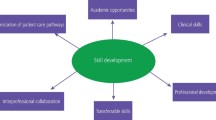Abstract
Aims To assess the training programme and future career choices of newly qualified dental trainees.
Methods Mixed-methods study combining a national questionnaire with focus groups administered to dental foundation trainees (DFTs) in England. Two regions chose not to participate; therefore, the questionnaire was sent to 588 DFTs and 226 (38.4%) responded. Forty-one DFTs participated in six regional focus groups.
Results Location was the primary factor when choosing a training post, with 86% wanting to live and work near friends and family. Other influencers included affordability, availability of good training facilities and transport links, and proximity to their dental school. Focus group data found that perceived higher-quality training schemes were chosen over location in some circumstances. Most trainees wanted a career as an associate (67%) rather than a practice partner (32%) or owner (27%). Thirty-one percent aimed to practise on a private basis and 40% wanted to remain within the NHS. Women were significantly more likely than men to consider part-time working patterns (X2(2) = 9.761, p = 0.002). Part-time working was attractive as many found full-time clinical dentistry too stressful.
Conclusions Geographical location is the key influencer on where dentists want to work and consideration needs to be given to interventions to address geographical disparities in graduate destinations. The strong desire to work part-time raises concerns about current workforce planning.
Key points
-
Part-time working patterns appeal to newly qualified dentists.
-
Trainees primarily choose training posts based on location.
-
Trainees can choose training posts that they perceive to offer better training even if this is in a less popular location.
This is a preview of subscription content, access via your institution
Access options
Subscribe to this journal
Receive 24 print issues and online access
$259.00 per year
only $10.79 per issue
Buy this article
- Purchase on Springer Link
- Instant access to full article PDF
Prices may be subject to local taxes which are calculated during checkout


Similar content being viewed by others
References
Handy C B. The age of unreason. Boston : Business Books, 1989.
Portfolio Careers. BMJ 1996; DOI: 10.1136/bmj.313.7057.2.
British Dental Association. Portfolio Career. 2019. Available at https://www.bda.org/careers/Othercareeroptions/Pages/Portfolio-career.aspx (accessed February 2021).
NHS Digital. Dental Working Hours - 2016/17 and 2017/18: Working Patterns, Motivation and Morale. 2018. Available online at https://digital.nhs.uk/data-and-information/publications/statistical/dental-working-hours/2016-17-and-2017-18-working-patterns-motivation-and-morale (accessed February 2021).
Fine P, Leung A, Francis J, Louca C. The Use of Picture Cards to Elicit Postgraduate Dental Student Feedback. Dent J (Basel) 2018; 6: 7.
Braun V, Clarke V. Using thematic analysis in psychology. Qual Res Psychol 2006; 3: 77-101.
Triggle N. Millions 'missing out' on NHS dentistry. 2019. Available at https://www.bbc.co.uk/news/health-50467776 (accessed February 2021).
Batchelor P. Registration and retention of dentists on the General Dental Council register between 2006 and 2016. Br Dent J 2018; 224: 105-109.
Collin V, Toon M, O'Selmo E, Reynolds L, Whitehead P. A survey of stress, burnout and well-being in UK dentists. Br Dent J 2019; 226: 40-49.
Royal College of Physicians. Focus on physicians: 2018-19 census. 2019. Available online at https://www.rcplondon.ac.uk/projects/outputs/focus-physicians-2018-19-census-uk-consultants-and-higher-speciality-trainees (accessed February 2021).
Joyce C M. The medical workforce in 2025: what's in the numbers? Med J Aust 2013; 199(5 Suppl): S6-S9.
Henry A, Clements S, Kingston A, Abbott J. In search of work/life balance: trainee perspectives on part-time obstetrics and gynaecology specialist training. BMC Res Notes 2012; 5: 19.
Newton J, Buck D, Gibbons D. Workforce planning in dentistry: The impact of shorter and more varied career patterns. Community Dent Health 2002; 18: 236-241.
Boulos M N K, Phillipps G P. Is NHS dentistry in crisis? 'Traffic light' maps of dentists distribution in England and Wales. Int J Health Geogr 2004; 3: 10.
Li J, Scott A, McGrail M, Humphreys J, Witt J. Retaining rural doctors: Doctors' preferences for rural medical workforce incentives. Soc Sci Med 2014; 121: 56-64.
Acknowledgements
With thanks to Health Education England (HEE) North West and the wider Advancing Dental Care team for supporting the research with funding for the transcription service and allowing staff to support the focus groups. Special thanks to HEE staff Paul Leavy, Emily Hall and Alexandra Coleman for travelling the country to host focus groups.
Author information
Authors and Affiliations
Corresponding author
Electronic supplementary material
Rights and permissions
About this article
Cite this article
Thomson, F., Macey, R., O’Malley, L. et al. Factors influencing dental trainees' choice of training programme and working patterns: a mixed-methods study. Br Dent J 230, 363–368 (2021). https://doi.org/10.1038/s41415-021-2725-5
Received:
Accepted:
Published:
Issue Date:
DOI: https://doi.org/10.1038/s41415-021-2725-5
This article is cited by
-
Recruitment and retention in dentistry in the UK: a scoping review to explore the challenges across the UK, with a particular interest in rural and coastal areas
British Dental Journal (2023)
-
The dental workforce recruitment and retention crisis in the UK
British Dental Journal (2023)



